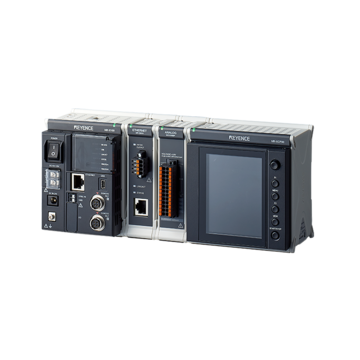Data Acquisition (DAQ)
- Temperature Measurement for the Electronic Device Industry
- Temperature Measurement for the Electrical Equipment Industry
- Temperature Measurement for the Metal and Steel Industry
- Temperature Measurement for Plastics Industry
- Voltage Measurement for the Automotive Manufacturing Industry
- Voltage Measurement for Electric Vehicle Industry
Selecting a Voltage Measurement Data Logger
Instruments used for voltage measurement include oscilloscopes, high-speed waveform recorders (Memory HiCorders), and data loggers. There are numerous types of each of these instruments, so it is difficult to select the ideal instrument for a specific measurement. A lot of time is required for the comparison and consideration of these instruments.
For many years, KEYENCE has provided data loggers to a large number of R&D and manufacturing sites. Based on our accumulated knowledge, this section explains the key points in selecting ideal instruments—with the main focus on data loggers—for voltage measurement. This section also introduces the characteristics of KEYENCE data loggers, which are compact, lightweight, scalable, and compatible with PCs.
Different Instruments Used for Measuring Voltage
This section explains the general types of instruments used for voltage measurement and their characteristics and applications.
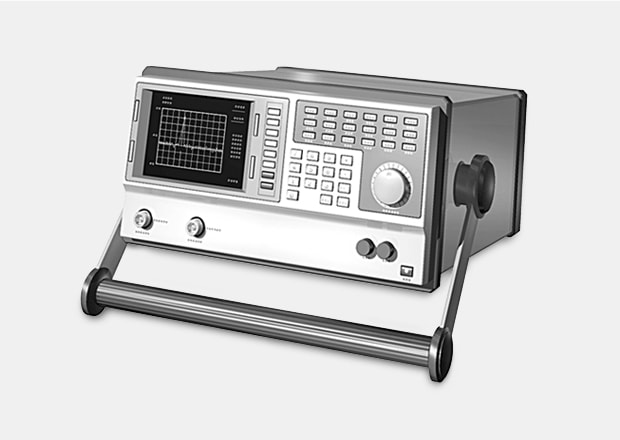
Oscilloscope
Used to observe the waveforms of high-speed electric signals such as when checking the signals from electronic circuits and when checking the properties of electronic components. Oscilloscopes are suited for short-term observation, such as accurately measuring the time during which a change occurs. Oscilloscopes offer various types of triggers, are mainly designed for sampling speed, waveform display, and direct operability, and are expensive.
| Sampling cycle | 10 MHz to Several GHz and above |
|---|---|
| Number of channels | 2 to 8 |
| Resolution | 8 bits (full scale × 1/256) |
| Remarks | Not suited for long-time continuous recording |
Scroll
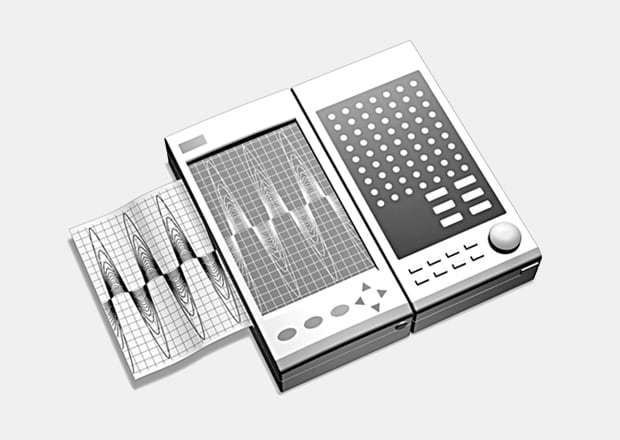
High-Speed Waveform Recorder
Mainly used to observe or record waveforms that change at mid-speed, such as analog signals (e.g. vibrations) and equipment control signals (logic signals). These recorders are multi-functional (for example, they have insulation inputs), and many of them are specifically designed for voltage, vibration, control signals, and similar applications. If data collection is your main purpose, these recorders may have excessive performance and be too expensive compared to data loggers.
| Sampling cycle | Several kHz to Several MHz |
|---|---|
| Number of channels | A few to 16 |
| Resolution | 12 to 14 bits |
| Remarks | Some high-speed waveform recorders have built-in A4-paper-sized printers capable of multi-channel printing and HDDs and are suitable for mid-to-long-term waveform observation and data saving. In many cases, measurement units come as boards (PCBs) to be inserted. Linking with PCs is complicated and requires knowledge and experience. |
Scroll
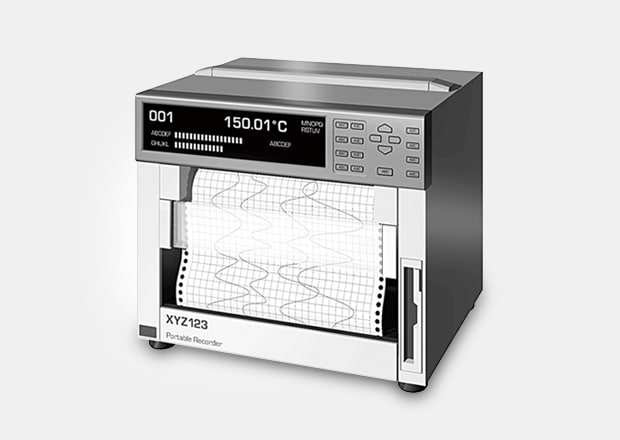
General-Purpose Recorders
In many cases, general-purpose recorders are used to observe low-speed changes such as temperature. These instruments are simply called “recorders.” General-purpose recorders are rarely used for multi-input applications such as voltage and logic signals. They are more commonly used for simple, low-speed data observation.
| Sampling cycle | 100 ms or more |
|---|---|
| Number of channels | 1 to 64 or more |
| Resolution | 14 to 16 bits |
| Remarks | Not suited to fields such as electric circuits, semiconductors, and LCD screens due to its low speed. Also, its compatibility with PCs is low, and many general-purpose recorders are not suited for the analysis of acquired data and report creation. |
Scroll
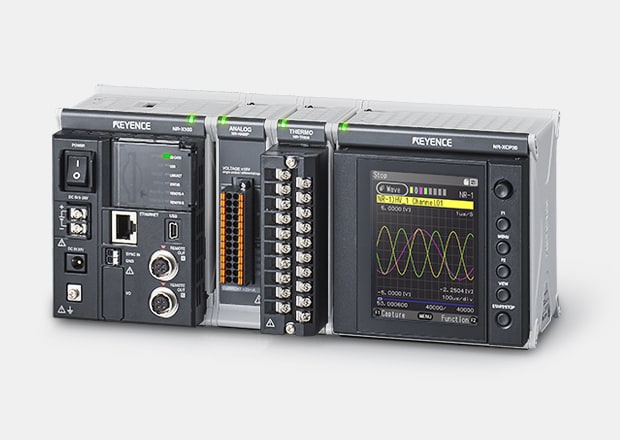
KEYENCE “NR Series” data logger
Data Logger
Capable of collecting various types of data, such as voltage and temperature, simultaneously and accurately from low- to mid- and high-speed using multiple channels.
This logger is highly scalable in combination with measurement units and is capable of collecting reliable data using its inter-channel insulation function, which is a big difference from general-purpose recorders.
| Sampling cycle | 10 Hz to 1 MHz |
|---|---|
| Number of channels | 4 to 576 or more |
| Resolution | 14 to 16 bits |
| Remarks | Users can collect mixed data such as voltage and temperature by combining measurement units. Many data loggers have simplified displays and operation buttons on main units and are less compatible with PCs. The key point in selection is the work efficiency during measurement and after data collection. Other important points include the visibility and operability of the main unit, the compatibility with PCs, the ease of data handling, and the availability of analysis and other necessary functions. |
Scroll
KEYENCE data loggers, which satisfy recent needs and solve problems with conventional data loggers, enable you to:
- Use useful display and analysis functions built into the main unit.
- Communicate with your PC wirelessly or send data at high speed through compression of CSV files.
- Process collected data all the way up to analysis using the dedicated software.
Nowadays, attention is being paid to data loggers that are highly compatible with PCs and can drastically improve the efficiency of subsequent work.
Choosing a Voltage Data Logger for Scalability, Cost, and Functionality of Channels
When using a data logger for voltage measurement, the voltage and the number of channels that can be measured vary depending on the types of measurement units to be combined.
One of the advantages of a data logger is its capability to support high voltage and multi-channel measurement through the selection and combination of measurement units ideal for your purpose. For reliable voltage measurement even with multiple channels, the availability of the “inter-channel insulation function” is also an important point to consider.
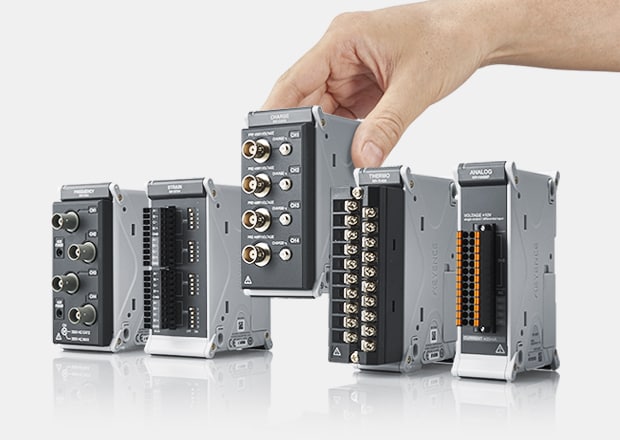
Future Scalability and Channel Unit Price
If more channels may be required in the future, a modular data logger enables you to easily increase the number of channels simply by adding a measurement unit. This is economical because you do not have to replace the whole instrument.
Also, compared to channel extension with a high-performance, high-speed waveform recorder , a data logger is beneficial in its extensibility with a lower channel unit price while maintaining its high-speed sampling and high resolution.
Availability of Inter-Channel Insulation Selection (Inter-CH insulation)
For simultaneous measurement of multiple channels, the availability of the “inter-channel insulation (inter-CH insulation, or isolator)” function, which can reduce the effect of noise, is also an important point to consider.
Since most general-purpose recorders are not equipped with this insulation function, they may be affected by shifts in measured values or noise from other inputs during simultaneous voltage measurement. As a countermeasure against these issues, we recommend that you select a data logger equipped with the inter-channel insulation function.
Choosing a Voltage Data Logger for Accuracy and Sampling Speed
“Accuracy” can be defined and understood in various ways and may be recognized differently by different people. This section clarifies important types and ways to think about accuracy when you check the desired specifications for a data logger in product catalogs.
Defining Accuracy to Select the Required Specifications
It is necessary to clarify whether the fineness of the required measured values—that is, the “accuracy”—is the “minimum display digit” (the minimum digit you want to read) or the “absolute values.” The specifications required for an instrument vary depending on this.
- Minimum displayable digit = “Display resolution”
- Absolute values from which no further deviation occurs = “Absolute accuracy”
Once you clarify this, refer to the “measurement accuracy (accuracy)” for an instrument to check your required specifications.
The table below shows example specifications.
| Measurable range | Display resolution | ||
|---|---|---|---|
| Measurement range | ±1000 V | −1000.00 V to +1000.00 V | 50 mV |
| ±500 V | −550.00 V to +550.00 V | 20 mV | |
| ±200 V | −220.00 V to +220.00 V | 10 mV | |
| ±100 V | −110.000 V to +110.000 V | 5 mV | |
| ±50 V | −55.000 V to +55.000 V | 2 mV | |
| ±20 V | −22.000 V to +22.000 V | 1 mV | |
| ±10 V | −11.0000 V to +11.0000 V | 0.5 mV | |
| ±5 V | −5.5000 V to +5.5000 V | 0.2 mV | |
| ±2 V | −2.2000 V to +2.2000 V | 0.1 mV | |
| Measurement accuracy | ±0.1% of F.S. | ||
Scroll
“F.S.” written on the Measurement accuracy row refers to “full scale.” In the above table, the measurable range for a measurement range of ±5 V is -5.0 to 5.0, the F.S. is 10 V V. You can see that the measurement accuracy is ±0.1% x 10 V.
Relationship Between Sampling Speed and Accuracy/Resolution
Generally, there is a trade-off between the sampling speed (cycle) and the resolution. Even with the same measurement range, a lower resolution leads to a lower measurement accuracy. Therefore, it is important to select different instruments for different measurement targets. Also, note that an instrument that satisfies the needs of both accuracy and sampling speed tends to have a higher price.
Choosing a Voltage Data Logger for Operability, Linking with PCs, and Work Efficiency
Usually, data loggers are used by multiple people in a company, so it is important to keep these data loggers easy to handle and not overspecialized. Therefore, it is important to select a data logger that offers high work efficiency in various areas: settings, operation, work after data collection, linking with a PC, data analysis, and report creation. You also need to take into consideration the efficiency of error-proofing, status understanding during measurement, and work after measurement.
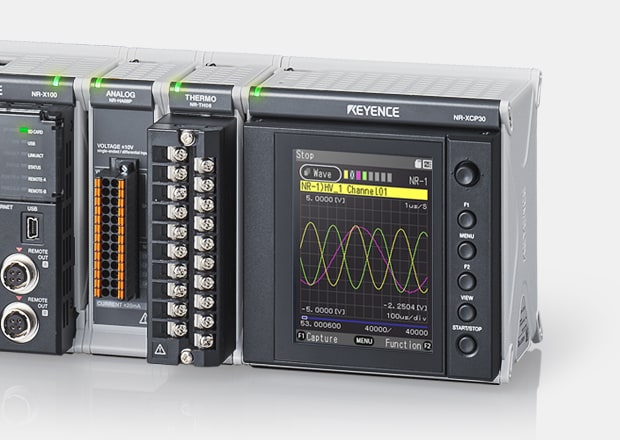
Ease of Settings, Operation, and Reading
Most data loggers only have simple indicators on the main units, and a minimal number of operation buttons is provided. Because settings and operations are assumed to be performed on PCs, the status of measurement is usually hard to understand on the main unit. This sometimes causes issues such as testing to be continued with no one recognizing that measurement has not been started.
You can prevent careless mistakes and improve your work efficiency by selecting a data logger that enables you to check the status of measurement and the measured data on the main unit monitor and also allows you to configure settings and perform operations easily without a PC.
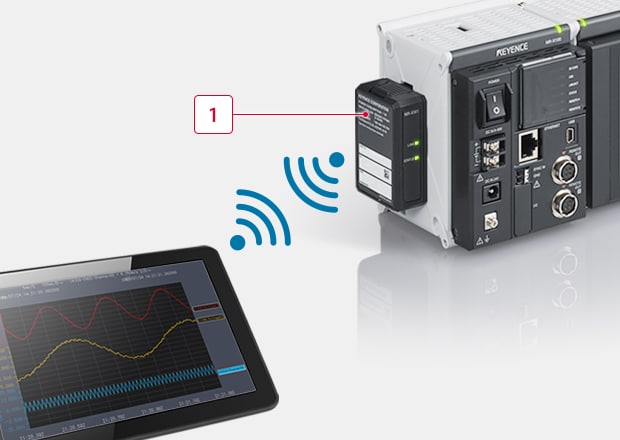
Methods for Connecting to Terminals
You also need to consider the method for connecting the data logger to terminals, such as PCs and tablets. It is necessary to consider whether only a wired connection will be used, with USB and Ethernet cables, or whether remote operation may be necessary from laptops and tablet terminals via wireless LAN connections.
For example, when acquiring automobile engine data in an onboard manner, a data logger that supports wireless connections enables you to not only save the time and effort required for complicated wiring but also to significantly reduce the risk of wiring problems.
-
1Wireless LAN unit NR-XW1
Wireless connection is also possible
without connecting through a corporate network
Methods for Saving Data
The way the acquired data is saved is also important. Data can be saved not only in the storage (such as an HDD or SSD) built into the connected PC but also in the large-capacity CF memory card inserted into the data logger.
By simultaneously saving data in both the PC and the data logger (mirror saving), you can also improve the safety and reliability of data saving.
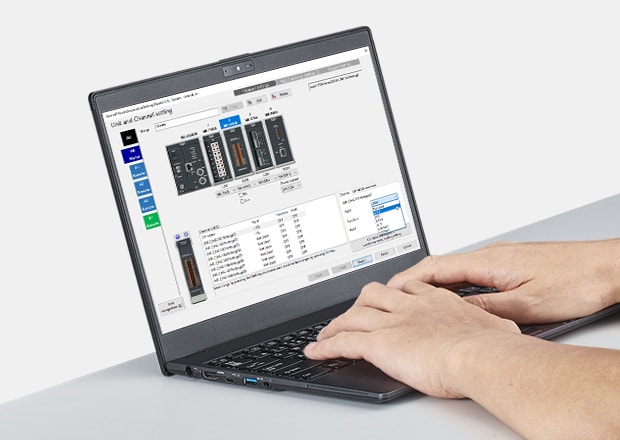
Compatibility with PCs, Ease of Post-Processing, and Work Efficiency
Most data loggers are mainly designed literally for “data logging.” This means post-processing with PCs, such as data collection and analysis, sometimes takes time and effort. However, you can greatly reduce the work hours by selecting a data logger that is highly compatible with PCs and Excel.
KEYENCE data loggers have been developed to maximize compatibility with PCs, with work efficiency taken into account.
- Enables easy connection to and detailed data display in the dedicated software.
- Reduces the data volume with the compressed CSV save function. Significantly reduces the time to send data to PCs.
- Drastically improves the efficiency of analysis on PCs with the dedicated analysis software.
- Greatly improves work efficiency, including direct data writing into Excel.
Choosing a Voltage Data Logger for Portability and Power Supply
Data loggers are used for data measurement in various locations, and in some cases, data loggers have specific size and portability requirements. Another important point in selection is whether data loggers can be operated on battery power in an environment where they cannot be connected to a 100 VAC power supply.
- Whether a data logger is only used at a specific installed location
- Whether a data logger may be moved to different locations
- Whether a data logger may be used in an environment where no 100 VAC power supply is available
- Whether a data logger can be operated on battery power
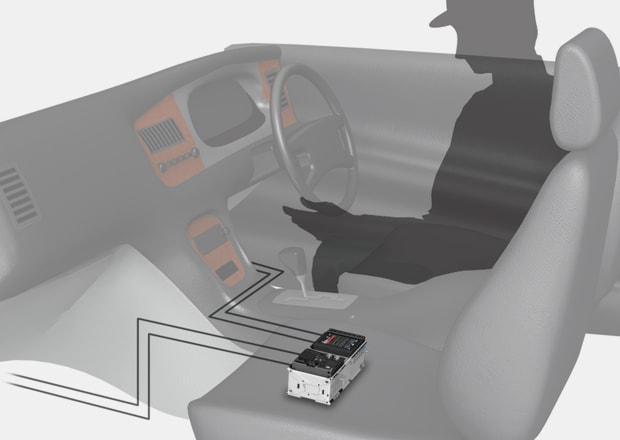
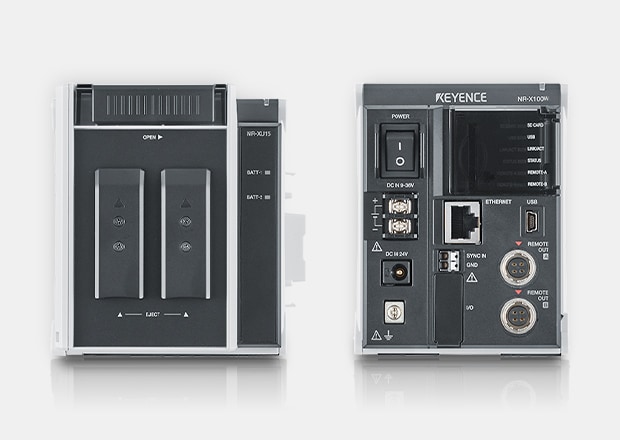
Left: Battery power supply unit for NR-X: NR-XU15
Right: Master data collection unit NR-X100W
If it becomes necessary to move a data logger to use it in a different location, the problem of portability arises for large or heavy data loggers. Additionally, the question of whether power can be supplied by not only an AC power supply but also by a battery becomes important.
Choosing a Voltage Data Logger to Simultaneously Measure Data Other Than Voltage
The required instrument configuration varies if you are likely to simultaneously measure multiple pieces of data other than voltage, such as temperature, current, strain, and acceleration.
This section explains problems that arise depending on how the instrument to be installed is selected, solutions to these problems, and advantages when a multi-input data logger is used.
Problems with the Conventional Method
Installation and Use of Several Instruments
One method to employ in measuring data other than voltage is using external equipment to convert this data to voltage and employing dedicated data loggers for each of the other pieces of data. However, this method is very expensive because several instruments must be installed. It also raises problems such as complicated systems and wiring, finding ways to synchronize the data , and a lot of effort and man-hours required for management and processing of multiple pieces of data after measurement.
Solution Using a Data Logger
Batch Collection of Multiple types of Data with a Single Unit
It is recommended that you select a multi-input data logger if it is likely to simultaneously measure data other than voltage.
A single data logger that can collect multiple types of data tends to be more expensive than instruments that record only a single type of data. However, when the purchasing of multiple converters and dedicated loggers is taken into account, the installation will result in almost the same cost.
Although the installation cost is almost the same, a multi-input data logger has the following advantages.
- Reduces post-measurement man-hours thanks to batch collection and analysis of multiple types of data.
- Reduces the number of wiring lines, which may cause problems, through concentrated equipment.
- Offers a mostly unified usage method, as well as smooth setup and troubleshooting.
- Easy to receive support because various input units are also provided by the same manufacturer.
Summary
So far, this section has explained how to select a data logger for voltage measurement. Important points in selection can be summarized as follows.
Scalability, Cost, and Functionality of the Number of Channels
Consider the scalability in channel extension. It is also important to use insulation to take measures against potential problems.
Accuracy and Sampling Speed:
Clarify the definitions of accuracy and resolution to check your required specifications.
Operability, Compatibility with PCs, and Post-Processing Efficiency
Easiness of settings, operation, and reading. Easy connection to PCs, data transfer/analysis functions, and compatibility with Excel directly affect post-processing man-hours.
Portability and the Power Supply Environment
Whether an AC power supply is always available and whether operation on battery power may be necessary.
Simultaneous Measurement of Multiple Types of Data
Whether the system configuration is simple and reliable when data other than voltage is simultaneously measured.
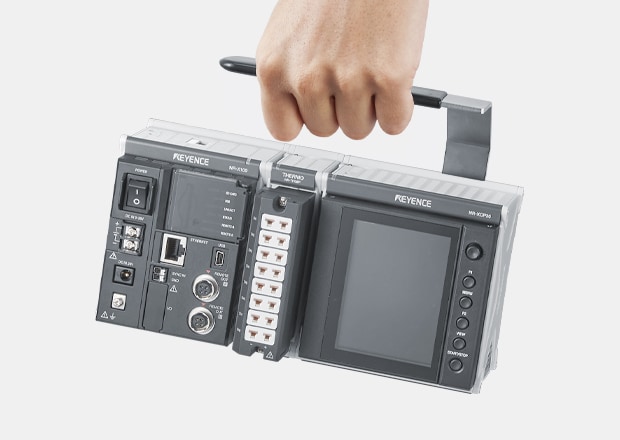
KEYENCE’s Multi-Input Data Collection System “NR Series” features a compact design with superior portability while still offering high scalability and reliability. This data logger has been developed to maximize compatibility with PCs and Excel, thereby significantly improving your work efficiency. The “NR Series” has been chosen not only for voltage measurement for R&D, quality assurance, and manufacturing sites but also for the simultaneous collection of multiple types of data.
FAQs about Voltage Data Loggers
What are the key factors to consider when choosing a voltage measurement data logger?
As discussed above, there are several key factors to consider to ensure the most accurate and efficient data logging. For example, the scalability of your data logging system is crucial, especially if you have future expansion in mind. This simply makes the data logger more cost-effective in the long run.
Accuracy and sampling speed are also crucial, and it’s essential to find the right balance between the two due to their seemingly trade-off relationship. High-speed loggers may sacrifice resolution for speed, making it much more important to these specs with data logger voltage measurement requirements.
You should also consider portability and power supply options for measuring voltage, particularly for field-work voltage data loggers, where power sources may vary in their output. And lastly, consider devices that are capable of measuring parameters in addition to voltage.
How does inter-channel insulation affect the performance of a voltage data logger?
Inter-channel insulation, or isolation, is among the most critical features in voltage data loggers, especially in applications that demand the simultaneous use of multiple channels. In applications where different channels might have vastly different voltage levels, signals become susceptible to noise, leading to inaccurate readings.
The role of inter-channel insulation is to ensure that the readings on one channel aren’t affected by the readings and fluctuations on another, greatly reducing channel-to-channel interferences and enhancing measurement accuracy. This is important in complex electrical environments in which high precision is required. Without adequate insulation, there’s an increased risk of cross-talk or noise affecting the quality of acquired and logged data, which is why insulation is critical to high-precision applications.
Why is the relationship between sampling speed and accuracy/resolution important in a voltage data logger?
To answer this question adequately, we must understand the relationship between sampling speed and accuracy, as these factors directly impact the quality of data collected by the voltage data logger.
Sampling speed refers to how fast the logger can record data points per second, and high-speed sampling is a must in applications that require capturing rapid voltage changes but can compromise on the resolution.
Resolution refers to the smallest change that the voltage data logger can detect. Conversely, higher resolution implies more detailed data, which also requires slower sampling to achieve more accurate measurements. Faster and less detailed data might suffice for general monitoring, but long-term monitoring demands slower and more detailed data collection to capture the voltage fluctuations of interest.
Why are interfacing and compatibility important?
A voltage data logger equipped with a USB interface can easily connect to the PC and offload data onto the personal computer’s storage for subsequent processing or analysis. These loggers are easier to connect, which streamlines data acquisition and the transfer, review, and storage of collected data.
Compatibility is also important, especially with software like Excel, which is capable of further simplifying data handling, manipulation, grabbing, and sharing. Overall, having a voltage data logger that can connect to the PC and is compatible with Excel or similar data analysis programs can streamline the whole process and make it more efficient and user-friendly.
If you have more questions about data loggers, contact us today.
Related Downloads
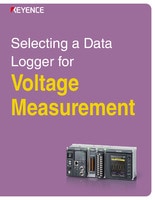
Learn about how to choose the best DAQ for voltage measurement based on several key points, including the maximum voltage being measured, the number of channels, accuracy, sampling rate, and simultaneous measurement with input signals other than voltage.
Related Products
Industries
- Temperature Measurement for the Electronic Device Industry
- Temperature Measurement for the Electrical Equipment Industry
- Temperature Measurement for the Metal and Steel Industry
- Temperature Measurement for Plastics Industry
- Voltage Measurement for the Automotive Manufacturing Industry
- Voltage Measurement for Electric Vehicle Industry

